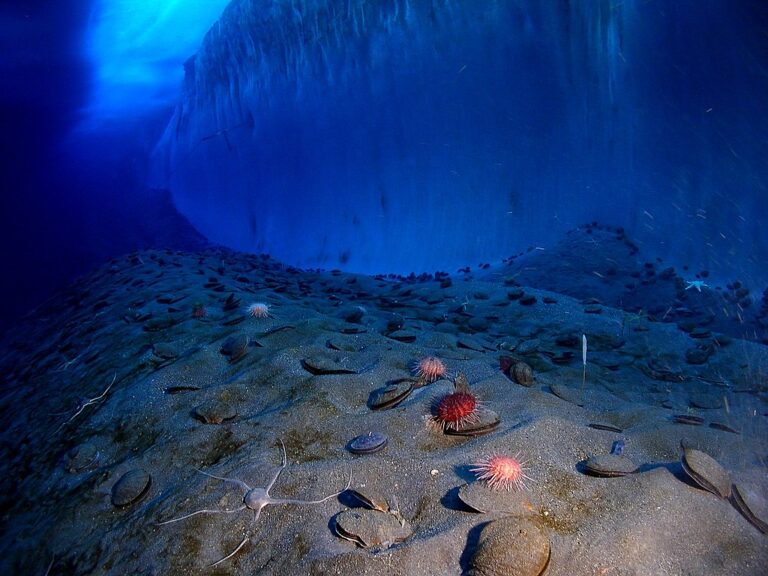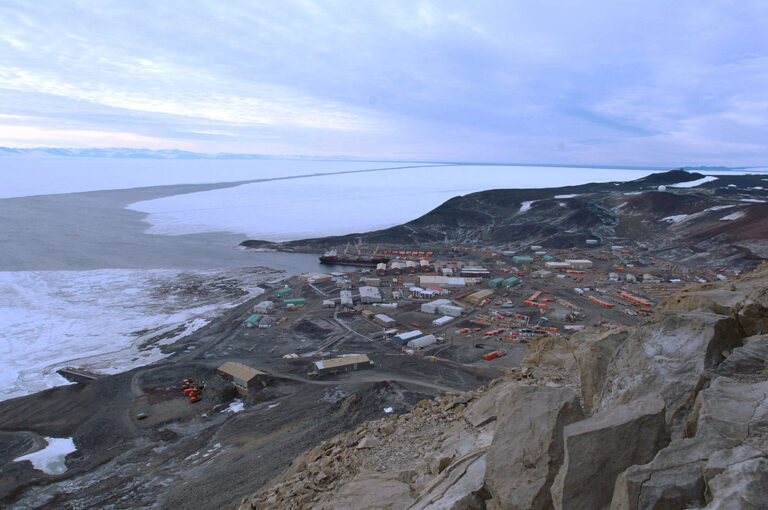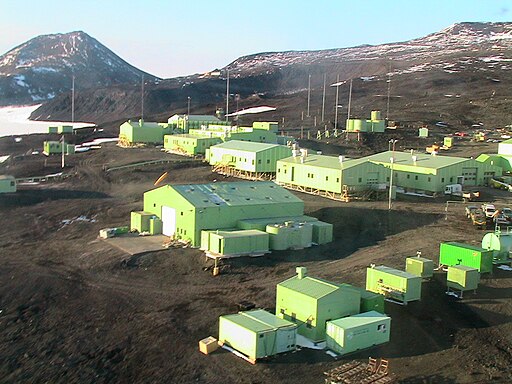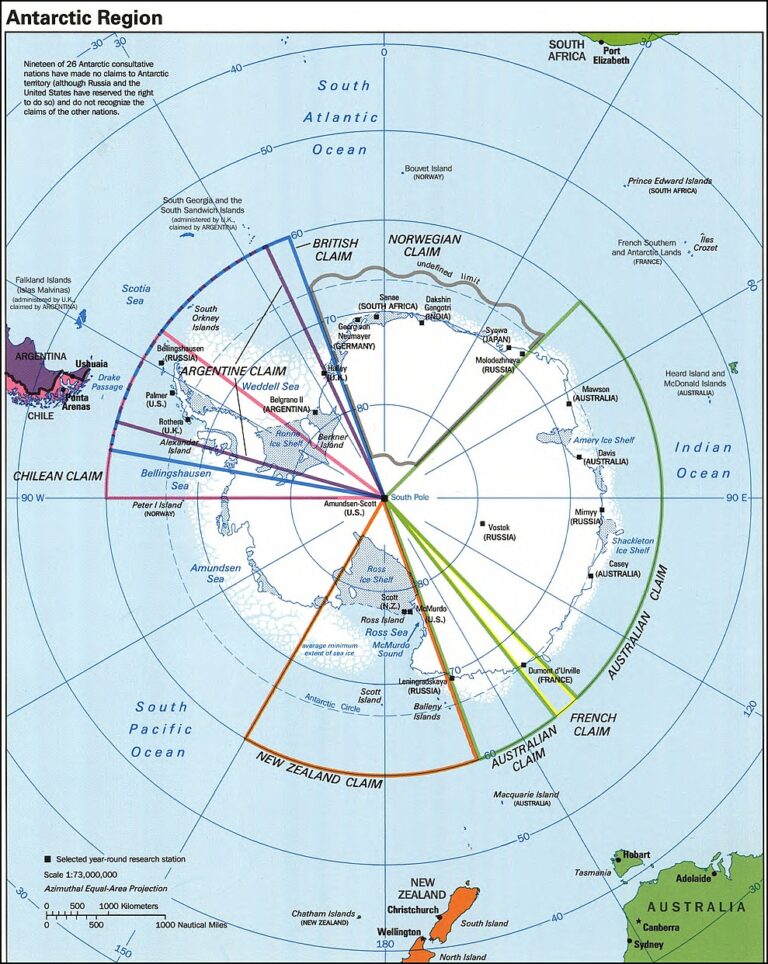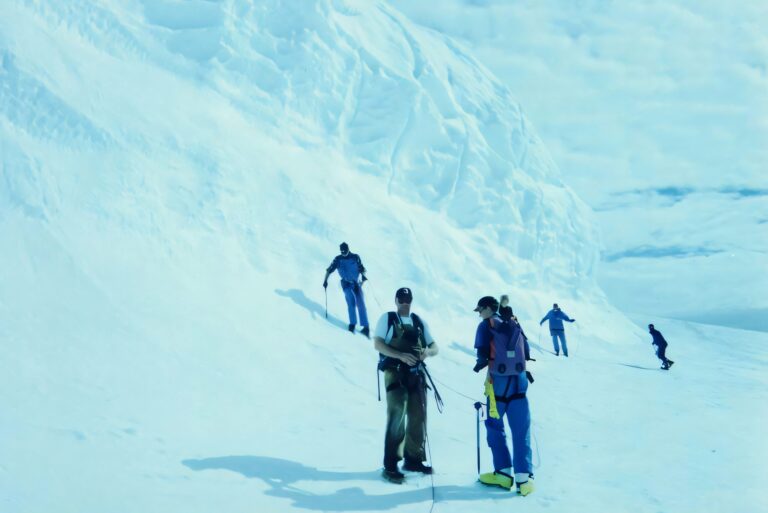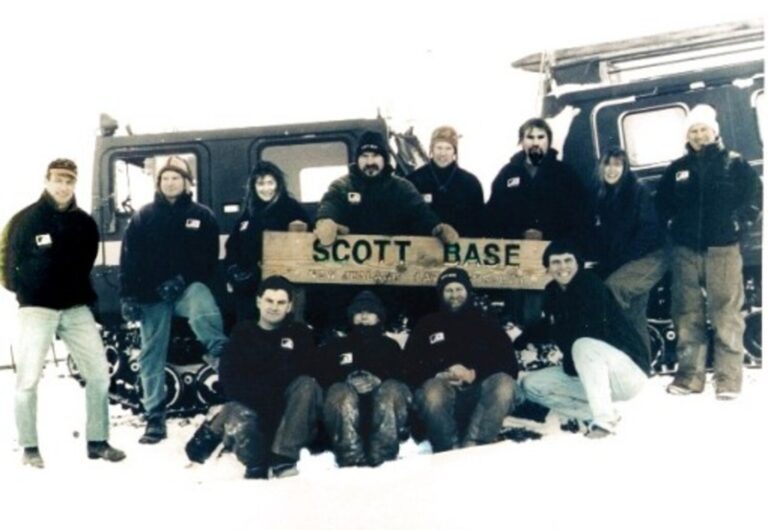Antarctic Land Claims
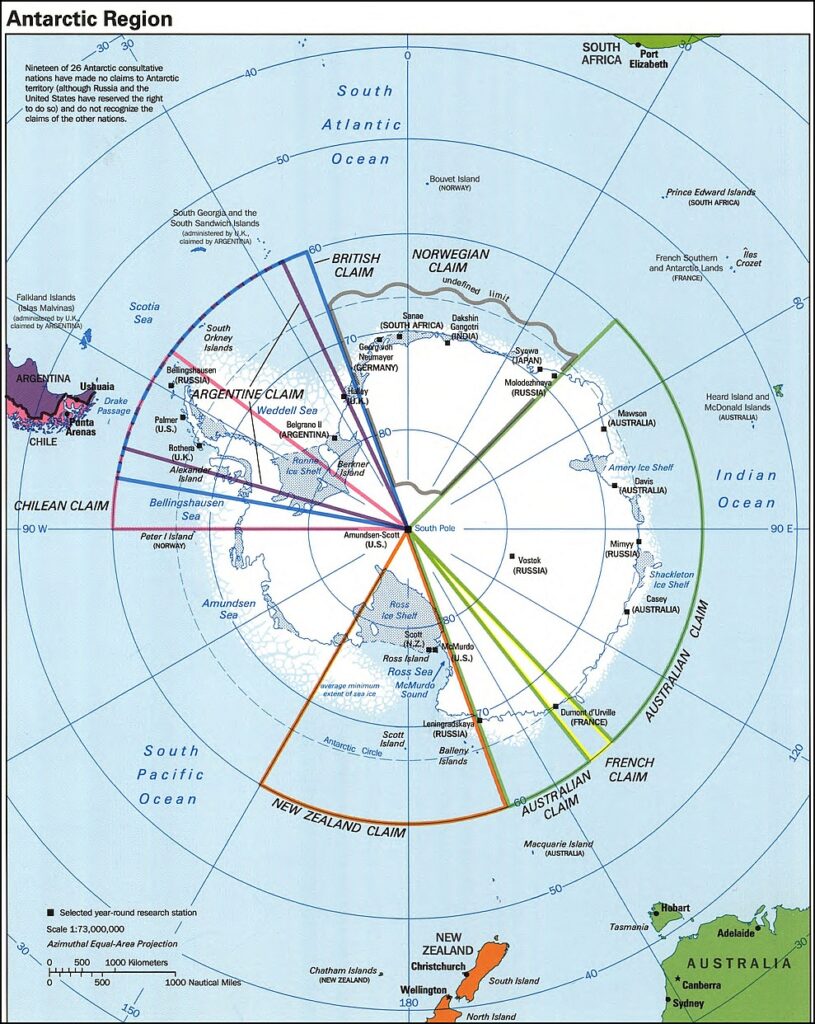
Overview - Antarctic Land Claims
1. Introduction
Have you ever wondered what’s going on way down at the bottom of the world, in Antarctica? It’s not just a giant ice block; it’s actually a place that countries around the world are very interested in. You see, even though it’s cold and desolate, Antarctica is divided up like a pie—at least on paper. Countries have made claims to different parts of this frozen land, saying, “This slice is ours!” But it’s not that simple. The land isn’t actually owned by anyone, thanks to something called the Antarctic Treaty.
The Antarctic Treaty was signed back in 1959, and it was a pretty big deal. Why? Because it was a promise by countries all around the world to keep Antarctica peaceful. No fighting over land, no military bases, and no digging up resources like oil or minerals—at least for now. Instead, Antarctica was set aside for scientific research, where people could study the climate, wildlife, and more without worrying about politics.
But here’s the catch—some countries don’t agree with these rules. And as we get closer to the year 2048, when parts of the treaty might change, more and more people are asking: what’s going to happen to Antarctica? Will the countries that have claimed parts of it start fighting over resources? Will the rules be ignored? That’s what makes all of this so interesting—and a little bit worrying.
In this blog, we’ll explore these questions together. We’ll look at why so many countries care about this icy place, how the continent has been theoretically divided, why the Antarctic Treaty was created, and why some countries might decide to ignore it. By the end, you’ll have a much better understanding of why Antarctica is a big deal and why what happens there could affect us all.
2. Key Topics Covered
- How Antarctica is divided among different countries and why they’re interested in it.
- What the Antarctic Treaty is and why it was created.
- Why some countries don’t always follow the rules of the treaty.
- The big question: what might happen in 2048 when parts of the treaty could change?
Countries that have claimed parts of Antarctica and area claimed
| Country | Territory Name | Area Claimed (sq km) | Number of Research Stations | Source |
|---|---|---|---|---|
| United Kingdom | British Antarctic Territory | 1,709,400 | 4 | British Antarctic Territory, COMNAP |
| New Zealand | Ross Dependency | 450,000 | 3 | Ross Dependency, COMNAP |
| France | Adélie Land | 432,000 | 1 | Adélie Land, COMNAP |
| Australia | Australian Antarctic Territory | 5,896,500 | 3 | Australian Antarctic Territory, COMNAP |
| Norway | Queen Maud Land | 2,500,000 | 1 | Queen Maud Land, COMNAP |
| Chile | Chilean Antarctic Territory | 1,250,000 | 9 | Chilean Antarctic Territory, COMNAP |
| Argentina | Argentine Antarctica | 965,597 | 6 | Argentine Antarctica, COMNAP |
| Russia | N/A | No official claim | 9 | Antarctica (Russia), COMNAP |
| United States | N/A | No official claim | 6 | Antarctica (United States), COMNAP |
| China | N/A | No official claim | 4 | Antarctica (China), COMNAP |
Geopolitical Landscape and Territorial Claims
1. Territorial Claims in Antarctica: A Geopolitical Tug-of-War
Alright, let’s dive into the meat of the issue: why are so many countries interested in Antarctica, and how have they divvied it up? Believe it or not, Antarctica is technically divided among several countries, even though no one actually lives there permanently (except a few scientists here and there). These countries have drawn lines on maps, each one saying, “This part of the continent is ours!” But hold on—who decided that, and why do they even care?
Let’s start with the basics. Antarctica is unique because it’s not owned by any one country. Instead, it’s a place where nations have laid claims to certain parts, mostly because those regions are closest to them geographically. For example, Australia claims a huge chunk of the continent, which is directly south of it. The UK, Norway, and Argentina also have claims, as do a few other countries. Each one has its reasons—some historical, some strategic.
Here’s a little twist, though: not everyone agrees on these claims. The United States, for instance, doesn’t recognize any of them. And then there’s Russia and China, who are showing more interest in Antarctica without officially laying down claims. It’s a bit of a geopolitical dance, with countries trying to secure their interests without stepping on too many toes.
2. Why Countries Care About Antarctica
So why are these countries so keen on claiming pieces of a frozen desert? There are a few reasons. First off, there’s the potential for resources. Beneath all that ice, there might be valuable minerals, oil, and gas—things that could be worth a fortune if they can figure out how to get to them. Secondly, there’s the strategic importance. Having a foothold in Antarctica could be a big deal if, say, shipping routes change due to melting ice or if new technology makes resource extraction more feasible.
But it’s not just about money or strategy. For many countries, there’s a sense of national pride involved. Having a research station or a claim on Antarctica is like planting a flag on the moon—it’s a way to say, “We were here, we’re part of this global story.”
3. The Antarctic Treaty and Its Role
Now, this is where the Antarctic Treaty comes in. Back in 1959, twelve countries—including some of those with territorial claims—came together to sign this treaty. They agreed to set aside their differences and use Antarctica only for peaceful purposes, like scientific research. No military bases, no mining, no arguing over territory—just science and cooperation. Pretty cool, right?
But here’s the thing: not everyone always plays by the rules. Some countries have quietly expanded their activities, building new research stations or pushing the limits of what’s allowed under the treaty. And as we get closer to 2048, when parts of the treaty could be reviewed or changed, there’s a lot of uncertainty. Will the world continue to protect Antarctica, or will the race for resources begin in earnest?
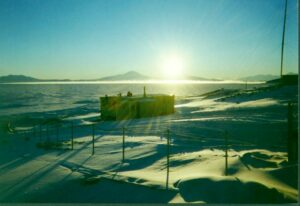
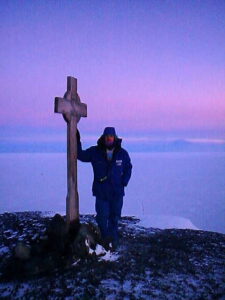
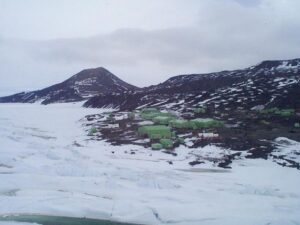
Timeline showing the key dates when different countries made their claims and when the Antarctic Treaty was signed, including major revisions.
| Date | Event | Country Involved | Source |
|---|---|---|---|
| 1908 | First territorial claim in Antarctica | United Kingdom | British Antarctic Territory |
| 1923 | Claim to Ross Dependency | New Zealand | Ross Dependency |
| 1924 | Claim to Adélie Land | France | Adélie Land |
| 1933 | Claim to Australian Antarctic Territory | Australia | Australian Antarctic Territory |
| 1939 | Claim to Queen Maud Land | Norway | Queen Maud Land |
| 1940 | Claim to Chilean Antarctic Territory | Chile | Chilean Antarctic Territory |
| 1943 | Claim to Argentine Antarctica | Argentina | Argentine Antarctica |
| 1959 | Antarctic Treaty Signed | 12 countries (including the U.S., Soviet Union, U.K., and others) | Antarctic Treaty |
| 1961 | Antarctic Treaty enters into force | 12 countries | Antarctic Treaty |
| 1991 | Madrid Protocol on Environmental Protection signed | Antarctic Treaty Consultative Parties | Madrid Protocol |
| 1998 | Madrid Protocol enters into force | Antarctic Treaty Consultative Parties | Madrid Protocol |
| 2048 | Scheduled review of the Antarctic Treaty | Antarctic Treaty Consultative Parties | Antarctic Treaty Review |
Environmental Concerns and Climate Change
1. Antarctica’s Fragile Environment: What’s at Stake?
Alright, now that we’ve covered the geopolitical tug-of-war over Antarctica, let’s talk about something just as important—if not more so: the environment. Antarctica isn’t just a chunk of ice; it’s a critical part of our planet’s climate system. This frozen continent plays a huge role in regulating Earth’s temperature, reflecting sunlight with its white surface and storing massive amounts of freshwater in its ice sheets.
But here’s the problem: Antarctica is more fragile than it looks. Even though it seems like an endless expanse of ice, small changes in temperature can have huge effects. And with the planet getting warmer, Antarctica is starting to melt faster than ever before. Scientists have been keeping a close eye on the ice sheets, and the data is pretty alarming. Over the past few decades, we’ve seen parts of Antarctica lose ice at an unprecedented rate, contributing to rising sea levels worldwide.
2. The Impact of Climate Change on Antarctica
Climate change isn’t just about warmer temperatures; it’s also about more extreme weather patterns. In Antarctica, this means stronger winds, shifting ocean currents, and changing sea ice conditions. All of these factors are making life harder for the animals that call Antarctica home—like penguins, seals, and whales. Their habitats are shrinking, and their food sources are becoming less reliable.
But it’s not just the animals that are affected. As Antarctica’s ice melts, it adds more water to the oceans, which can lead to higher sea levels. This isn’t just a problem for Antarctica; it’s a problem for everyone. Rising sea levels can cause flooding in coastal cities around the world, displacing millions of people and causing billions of dollars in damage.
3. Why Should We Care About Antarctica’s Environmental Health?
So, why should we care about what’s happening all the way down in Antarctica? Well, think of Antarctica as the planet’s air conditioner. When it starts to break down, the whole world feels the heat. The ice sheets in Antarctica hold enough water to raise global sea levels by about 60 meters if they were to melt completely. While that’s not happening tomorrow, even small increases in sea level can have big impacts.
Moreover, the changes in Antarctica can affect weather patterns around the globe. For example, the melting of Antarctic ice can disrupt ocean currents, which in turn can affect everything from the monsoon rains in Asia to the hurricane season in the Atlantic. In short, what happens in Antarctica doesn’t stay in Antarctica—it affects all of us.
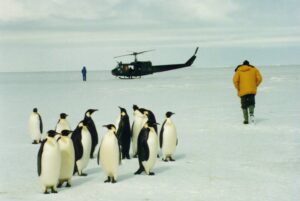

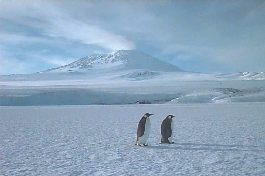
Trend of Ice Melt in Antarctica (1970-2020)
Sources:
- NASA GRACE Mission: NASA GRACE
- IPCC AR5 Report: IPCC
- Nature Climate Change Journal: Nature Climate Change
- European Space Agency (ESA): ESA
- Cryosphere Journal: Cryosphere
- NASA Earth Observatory: NASA Earth Observatory
- Science Journal: Science
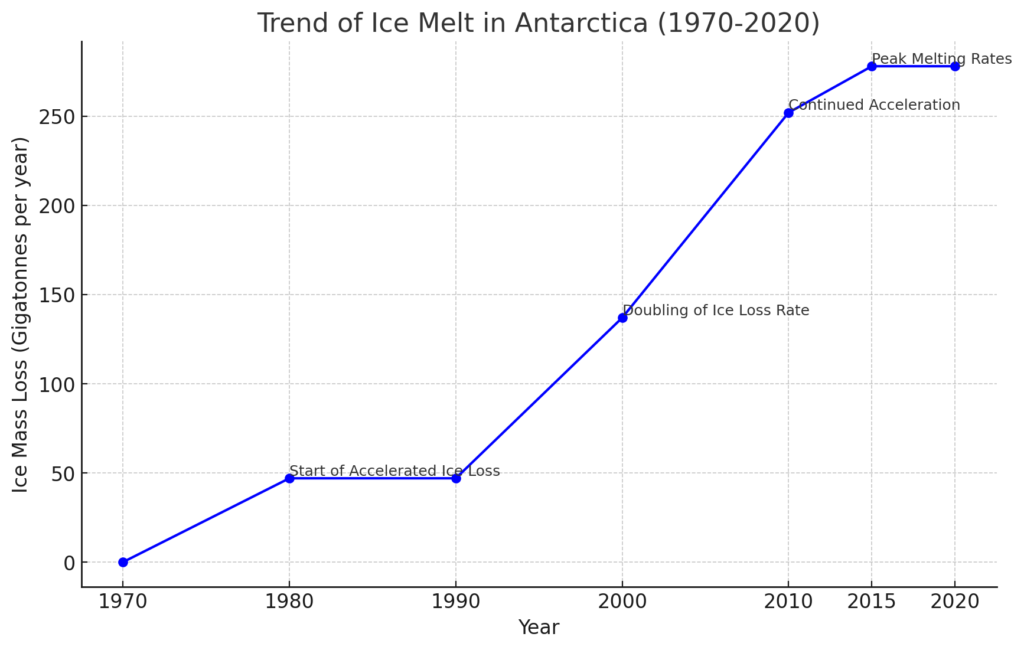
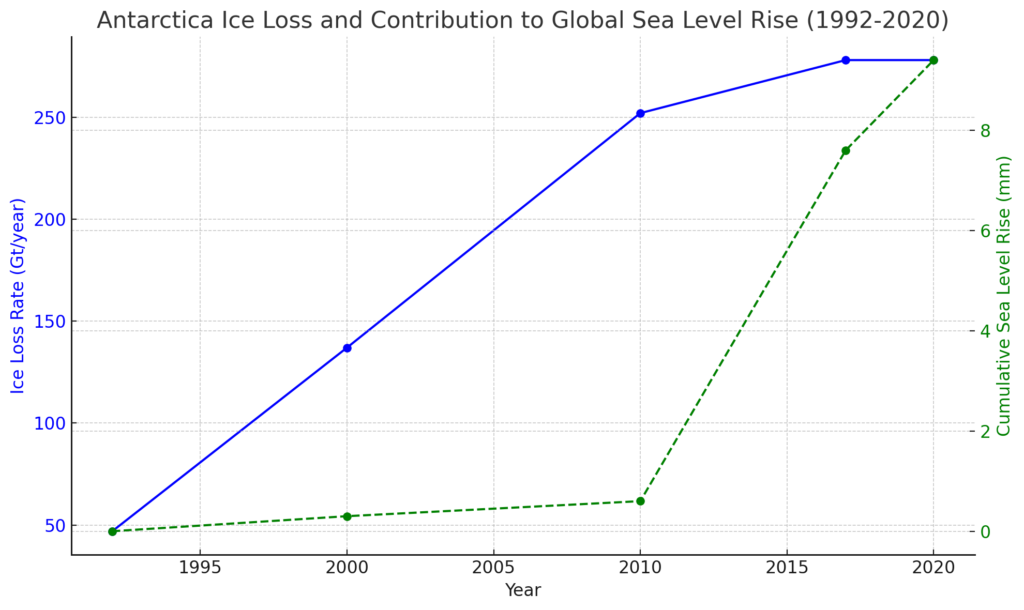
Sources:
- NASA GRACE Mission: NASA
- IPCC Reports: IPCC
- Nature Climate Change Journal: Nature Climate Change
- NASA Earth Observatory: NASA Earth Observatory
- IPCC Special Report on Global Warming of 1.5°C: IPCC
Resource Exploitation and Corporate Interests
1. Untapped Resources: Antarctica’s Wealth Beneath the Ice
Now, let’s talk about one of the biggest reasons so many countries are interested in Antarctica: what lies beneath the ice. We’re not just talking about penguins and seals here—there’s a whole treasure trove of resources hidden under the frozen surface. Scientists believe that Antarctica might hold vast amounts of oil, gas, and minerals, just waiting to be tapped into. Sounds tempting, right?
But here’s the catch: getting to these resources is incredibly difficult and expensive. We’re talking about drilling through kilometers of solid ice in some of the harshest conditions on Earth. Right now, most of these resources are out of reach, but that might not be the case forever. As technology improves and the world’s demand for resources grows, the pressure to start digging in Antarctica is likely to increase.
2. The Ethical Dilemma: To Mine or Not to Mine?
But just because we can do something doesn’t mean we should. There’s a huge ethical dilemma surrounding the idea of exploiting Antarctica’s resources. On one hand, these resources could provide energy and materials that the world desperately needs. On the other hand, mining and drilling could cause severe damage to Antarctica’s fragile environment, potentially destroying habitats and speeding up the already alarming rate of ice melt.
Many environmental groups, like Greenpeace, argue that Antarctica should remain untouched—a last frontier that humans leave alone. They worry that once the door is opened to resource extraction, it will be impossible to close. And they’re not alone. Even under the Antarctic Treaty, which currently bans mining, there’s concern that these protections might not hold up under the pressure of future demands.
3. Corporate Interests: Who Stands to Gain?
So, who’s really interested in getting their hands on Antarctica’s resources? Well, it’s not just the countries with territorial claims—it’s also big corporations. Oil companies, mining giants, and even tech firms could all potentially benefit from the resources hidden in Antarctica. These companies have the money, technology, and influence to push for changes in the rules that currently protect the continent.
But here’s where it gets tricky: many of these companies operate in multiple countries, and they have a lot of power. They can lobby governments, fund research that supports their goals, and influence public opinion through advertising and media. This means that the debate over whether to mine in Antarctica isn’t just happening in the halls of government—it’s also happening in boardrooms around the world.
4. The Role of Activism: Can We Keep Antarctica Safe?
Despite the powerful interests pushing for resource extraction, there’s also a strong movement working to keep Antarctica safe. Environmental organizations are fighting hard to ensure that the continent remains a place for science and peace, not profit. They’re raising awareness, organizing protests, and pushing for stronger international agreements to protect Antarctica.
But will it be enough? As we get closer to 2048, when parts of the Antarctic Treaty could be changed, the battle over Antarctica’s future is heating up. It’s not just a question of who will benefit from Antarctica’s resources—it’s also a question of what kind of world we want to live in.
Estimated reserves of key resources in Antarctica
| Resource | Estimated Reserves | Location in Antarctica | Source |
|---|---|---|---|
| Oil | Up to 36 billion barrels | Underlying continental shelf areas | US Geological Survey |
| Natural Gas | Approximately 135 trillion cubic feet | Offshore areas, particularly the Ross Sea | US Geological Survey, National Geographic |
| Coal | Significant deposits, quantity unspecified | Transantarctic Mountains | Encyclopædia Britannica, Scientific American |
| Iron Ore | Large, but speculative | Prince Charles Mountains | US Geological Survey, World Atlas |
| Chromium | Estimated at several million tonnes | Dufek Massif | US Geological Survey, Antarctica Research |
| Copper | Potentially large deposits, not quantified | Various locations, including coastal regions | US Geological Survey, National Geographic |
| Gold | Unknown, exploratory estimates only | Ellsworth Mountains | US Geological Survey, Scientific American |
| Uranium | Speculative, deposits likely present | Coastal regions | World Nuclear Association, National Geographic |
The Future of Antarctica
Governance and International Cooperation
1. Antarctica 2048: What’s Next for the Last Untouched Continent?
As we’ve explored, Antarctica is a land of immense importance—scientifically, environmentally, and geopolitically. But there’s a ticking clock on the way we currently govern this frozen continent. In 2048, the Antarctic Treaty, which has kept the peace and protected the environment for decades, is up for review. And with that review comes a lot of uncertainty.
So, what could happen? Well, it depends on who you ask. Some people believe that the treaty will be strengthened, with even stricter rules to protect Antarctica from exploitation. Others worry that the pressure for resources will lead to a weakening of the treaty, opening the door to mining, drilling, and other activities that could harm the environment.
2. The Antarctic Treaty: A History of Peace and Science
Let’s take a step back and look at why the Antarctic Treaty was created in the first place. Back in 1959, the world was in the middle of the Cold War. There was a lot of tension between the major powers, and Antarctica, with its strategic location and potential resources, could have easily become a battleground. But instead of fighting over it, twelve countries came together and agreed to set aside their differences. They decided that Antarctica would be used only for peaceful purposes, mainly scientific research.
This was a huge achievement—one of the first big examples of international cooperation during a very tense time. The treaty has worked remarkably well, keeping Antarctica free from military activity and commercial exploitation for over 60 years. But now, with the review coming up, there’s a lot at stake.
3. Challenges Ahead: Can We Keep Antarctica Protected?
One of the biggest challenges is that not all countries agree on what should happen next. Some countries, like the United States, have never recognized the territorial claims in Antarctica. Others, like Russia and China, have been expanding their presence on the continent, building new research stations and increasing their activities. These moves have raised concerns that the treaty might not be strong enough to prevent future conflicts or protect the environment.
Then there’s the issue of climate change, which is already having a big impact on Antarctica. As the ice melts and the environment changes, some countries might push for more access to the resources that are becoming easier to reach. This could lead to more tension and could even threaten the fragile peace that has existed for so long.
4. The Role of International Cooperation: Working Together for a Common Goal
Despite these challenges, there’s also a lot of hope. The Antarctic Treaty has shown that when countries come together, they can achieve great things. There’s a strong movement, both within governments and among the public, to keep Antarctica protected. Environmental groups, scientists, and many countries are pushing for the treaty to be renewed and even strengthened, with tougher rules to ensure that Antarctica remains a place for peace and science.
The key will be international cooperation. If countries can work together, as they have in the past, there’s a good chance that Antarctica can be preserved for future generations. But it won’t be easy. It will require careful negotiation, a commitment to protecting the environment, and a willingness to put the common good above national interests.
A Geopolitical Shift in Antarctica as China Cuddles Up To An American Base. The Neibourhood Is Not Amused !
China’s recent expansion of its Antarctic presence, marked by the establishment of its fifth research station, the Qinling base near the Ross Sea, has sparked international concern. China completed the construction of its Qinling base, close to the U.S. McMurdo Station, in early 2024 This development, coupled with China’s advanced satellite monitoring capabilities, has led to fears of potential military applications, despite the Antarctic Treaty’s restrictions. China’s ambitions are considered to be part of a broader strategy to increase influence in the region, driven by interests in krill fishing and potential resource extraction.
American officials have expressed apprehension about the base’s potential military applications, given its proximity to the U.S. McMurdo Station. New Zealand, which has territorial claims in the Ross Dependency, is also wary of China’s growing influence and presence in the region. Both countries are closely monitoring the situation.
Russia, too, is expanding its Antarctic activities, particularly in the lucrative krill fishing industry, which, like China, it has resisted regulating under the Antarctic Treaty System. These moves reflect a broader geopolitical competition in Antarctica, with countries like the U.S. maintaining their presence but focusing on scientific research rather than territorial expansion. As nations position themselves ahead of potential treaty renegotiations, the balance between scientific cooperation and strategic interests is increasingly in question.
These developments highlight the shifting geopolitical environment in Antarctica, raising concerns about the future of the Antarctic Treaty and the region’s environmental protections. Observers are watching closely as these activities could signal a new era of competition in the world’s southernmost continent. As global powers jostle for influence, the once-peaceful Antarctic landscape is becoming a hotbed of geopolitical tension
Sources:
- RAND Corporation analysis on China’s Antarctic ambitions(RAND Services). http://www.rand.org/pubs/commentary/2024/04/what-are-chinas-long-term-antarctic-ambitions.html
- ABC News and Reuters report on China’s new bases.
- Lowy Institute’s commentary on the changing dynamics in Antarctica.
Antarctica's Future is Possibly at a Crossroads, So Will 2048 Change Everything, or Anything?
1. Antarctica 2048: What’s Next for the Last Untouched Continent?
As we’ve explored, Antarctica is a land of immense importance—scientifically, environmentally, and geopolitically. But there’s a ticking clock on the way we currently govern this frozen continent. In 2048, the Antarctic Treaty, which has kept the peace and protected the environment for decades, is up for review. And with that review comes a lot of uncertainty.
So, what could happen? Well, it depends on who you ask. Some people believe that the treaty will be strengthened, with even stricter rules to protect Antarctica from exploitation. Others worry that the pressure for resources will lead to a weakening of the treaty, opening the door to mining, drilling, and other activities that could harm the environment.
2. The Antarctic Treaty: A History of Peace and Science
Let’s take a step back and look at why the Antarctic Treaty was created in the first place. Back in 1959, the world was in the middle of the Cold War. There was a lot of tension between the major powers, and Antarctica, with its strategic location and potential resources, could have easily become a battleground. But instead of fighting over it, twelve countries came together and agreed to set aside their differences. They decided that Antarctica would be used only for peaceful purposes, mainly scientific research.
This was a huge achievement—one of the first big examples of international cooperation during a very tense time. The treaty has worked remarkably well, keeping Antarctica free from military activity and commercial exploitation for over 60 years. But now, with the review coming up, there’s a lot at stake.
3. Challenges Ahead: Can We Keep Antarctica Protected?
One of the biggest challenges is that not all countries agree on what should happen next. Some countries, like the United States, have never recognized the territorial claims in Antarctica. Others, like Russia and China, have been expanding their presence on the continent, building new research stations and increasing their activities. These moves have raised concerns that the treaty might not be strong enough to prevent future conflicts or protect the environment.
Then there’s the issue of climate change, which is already having a big impact on Antarctica. As the ice melts and the environment changes, some countries might push for more access to the resources that are becoming easier to reach. This could lead to more tension and could even threaten the fragile peace that has existed for so long.
4. The Role of International Cooperation: Working Together for a Common Goal
Despite these challenges, there’s also a lot of hope. The Antarctic Treaty has shown that when countries come together, they can achieve great things. There’s a strong movement, both within governments and among the public, to keep Antarctica protected. Environmental groups, scientists, and many countries are pushing for the treaty to be renewed and even strengthened, with tougher rules to ensure that Antarctica remains a place for peace and science.
The key will be international cooperation. If countries can work together, as they have in the past, there’s a good chance that Antarctica can be preserved for future generations. But it won’t be easy. It will require careful negotiation, a commitment to protecting the environment, and a willingness to put the common good above national interests.
Current research projects in Antarctica
| Focus Area | Research Project | Country/Organization | Objective |
|---|---|---|---|
| Climate Change | Antarctic Climate Change and Ecosystems (ACCE) | Australia, UK, USA | Investigate the impacts of climate change on Antarctic ecosystems, focusing on ice sheet dynamics and ocean interactions. |
| Climate Change | Monitoring of Antarctic Ice Sheets | NASA, ESA, IPCC | Measure changes in ice mass and sea-level contributions using satellite data and ground observations. |
| Biodiversity | Antarctic Peninsula Biodiversity Project | Argentina, Chile, UK | Study the diversity of species in the rapidly warming Antarctic Peninsula, focusing on adaptation and survival. |
| Biodiversity | SCAR Antarctic Biodiversity Portal | Scientific Committee on Antarctic Research (SCAR) | A global database project to document and monitor species diversity across Antarctica. |
| Geology | ANDRILL (Antarctic Drilling Project) | USA, New Zealand, Italy, Germany | Drill into Antarctic bedrock to study past climate conditions and understand the geological history of Antarctica. |
| Geology | Subglacial Lake Exploration | UK, USA, Russia | Explore subglacial lakes to uncover clues about Antarctica’s geological history and potential microbial life. |
| Glaciology | IceCube Neutrino Observatory | USA (University of Wisconsin-Madison) | Detect high-energy neutrinos using a detector embedded in the Antarctic ice sheet, contributing to both particle physics and glaciology. |
| Oceanography | Southern Ocean Carbon and Climate Observations and Modeling (SOCCOM) | USA (Princeton University), Australia | Study the role of the Southern Ocean in global carbon cycles and climate, focusing on ocean currents and carbon storage. |
| Atmospheric Science | Antarctic Ozone Hole Monitoring | NASA, NOAA, ESA | Track and analyze the Antarctic ozone hole, focusing on its recovery and impacts on atmospheric conditions. |
| Microbiology | Antarctic Microbiome Research | South Korea, USA, Germany | Investigate microbial life in extreme Antarctic environments, focusing on biodiversity and potential biotechnological applications. |
Sources:
- Scientific Committee on Antarctic Research (SCAR): SCAR
- NASA Earth Observatory: NASA Earth Observatory
- European Space Agency (ESA): ESA
- Antarctic Climate Change and Ecosystems (ACCE): Australian Antarctic Division
- IceCube Neutrino Observatory: IceCube
- Southern Ocean Carbon and Climate Observations and Modeling (SOCCOM): SOCCOM
Conclusion
1. Wrapping It All Up: Why Antarctica Matters
We’ve taken quite a journey through the icy expanse of Antarctica, exploring everything from territorial claims to the environmental stakes and the uncertain future of this unique continent. By now, it should be clear that Antarctica is much more than just a remote, frozen wilderness. It’s a vital part of our planet’s climate system, a place of incredible scientific discovery, and unfortunately, a potential battleground for resource exploitation and geopolitical tension.
The Antarctic Treaty has played a crucial role in keeping this continent peaceful and dedicated to science, but with the upcoming review in 2048, the future of Antarctica is anything but certain. As countries and corporations eye its untapped resources, the delicate balance that has kept Antarctica protected could be at risk.
2. The Bigger Picture: What’s at Stake for the World
But why should we, sitting miles away from the South Pole, care about what happens in Antarctica? The answer is simple: what happens in Antarctica affects us all. From rising sea levels due to melting ice, to the potential for global conflict over resources, the stakes are incredibly high. If we don’t take action now, the consequences could be felt by future generations all around the world.
The decisions made in the coming years will shape the fate of Antarctica—and by extension, the fate of our planet. Will we continue to protect this last great wilderness, or will we allow short-term interests to take precedence over long-term sustainability?
3. A Call to Action: How You Can Make a Difference
So, what can we do? While it might seem like these decisions are far beyond our control, there are still ways we can make a difference. Here are a few steps you can take:
- Stay Informed: Keep up with the latest news about Antarctica and the Antarctic Treaty. The more informed you are, the better you can advocate for its protection.
- Support Environmental Organizations: Consider supporting groups like Greenpeace or the World Wildlife Fund, which are working hard to keep Antarctica safe.
- Spread the Word: Share what you’ve learned with others. The more people who understand what’s at stake, the stronger the push will be to protect Antarctica.
- Advocate for Stronger Policies: Encourage your government representatives to support international agreements that protect Antarctica and to push for stronger environmental protections.
